Iran is one of the largest quality exporters of saffron in the world. Iranian Saffron is known as red gold … Ghayen, as Iran’s red gold capital, has a global brand of saffron.
Of course you need to know that Iran is the world’s leading producer of saffron. Iran mainly sells its saffron to Spain and some other countries and then they export it to other countries with their packaging.
If you want to buy saffron wholesale , click on the link
Contents
- 1 About Persian Saffron
- 2 Did you know Iran is the largest exporter of saffron in the world?
- 3 Types Of Saffron:
- 4 Use of saffron in Iranian food
- 5 History of saffron
- 6 Saffron Calories & Nutritional Value
- 7 Harvesting and Cultivation Saffron
- 8 Try Tea and Saffron
- 9 Try the Saffron and Milk
- 10 Try the Saffron and Rose Water
- 11 Also Ask About Saffron
About Persian Saffron
The plant was originally cultivated in Khorasan Razavi province and Southern Khorasan province, but was later cultivated elsewhere in Iran. The most important cultivation city in Iran is Ghayen and Torbat Heydariyeh. The highest quality saffron is also grown in this areas. Due to its great value, this plant is known as red gold and is the main income of the people in Khorasan cities.
Saffron is a plant that grows up to 30 cm high, and it can grow in harsh biological conditions. Also because of its warm nature it can withstand a great deal of cold weather, saffron onions continue to grow at a negative temperature of 40 degrees Celsius.
The plant only needs water in the beginning of November and it is sufficient for rain and snow until the first spring. Saffron is a plant that is not cost-effective in terms of transportation and is affordable.
Onion’s in cold regions with much rainfall is much better than in tropical regions, and one of the main reasons for distinguishing high quality saffron from inferior is the climate of the region, the colder the region, the higher the yield and quality of saffron.
Saffron has medicinal properties, and its most important characteristic is the joy that it is a drug against depression and used as a natural and herbal soothing drug. It is also used to flavor and color foods.
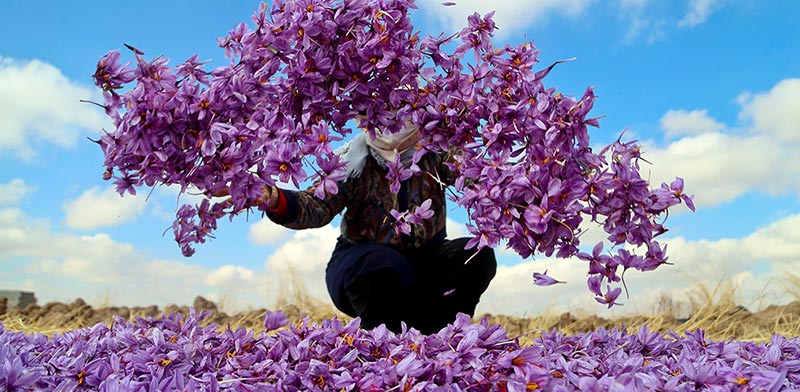 Did you know Iran is the largest exporter of saffron in the world?
Did you know Iran is the largest exporter of saffron in the world?
Iranian saffron is among the most imported goods in most countries. Although saffron is widely used in foodstuffs in Iran, most European countries use red-gold in the pharmaceutical industry, and since Iran is considered to be the most desirable producer in the world, many people around the world want this Iranian product.
According to Iranian customs statistics, the largest volume of saffron is given priority to the United Arab Emirates, Spain, China, Saudi Arabia, India, Sweden, Hong Kong, Italy, and Taiwan. Also, Iraq, Bahrain, Qatar, Kuwait, Oman, Afghanistan, Pakistan, Japan, Malaysia, Singapore, South Korea, Indonesia and Bangladesh, Turkmenistan, Kazakhstan, Russia, Armenia import Iranian saffron. Among the European countries, England, France, Germany, Finland, Austria, Norway, Denmark, Romania, Hungary, Greece, Bulgaria, and Ukraine have a significant share of their imports to Iranian saffron.
And in the Americas, the United States and Canada are among the countries importing Iranian saffron.
According to the latest global statistics in 2018, the total value exports is $ 218 billion, of which about 18.4 percent is China’s, 14.5 percent is India’s, and despite being Iran’s largest producer of red gold in the world, Some challenges, such Lack of proper packaging, crude sales, lack of brand, and lack of attention by government officials to the agricultural sector have led to the allocation of only 11.5 percent of total saffron exports to Iran.
Types Of Saffron:
” Each type is briefly described below, but if you want to know more about the product, planting method and harvest time, etc., the list of words below is a link. Just click on each item. ”
Negin Saffron
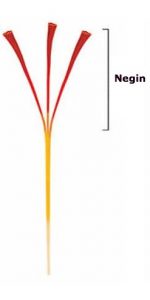
Negin saffron (Negin Pushal – Super Negin) is the most expensive type of saffron and has the highest coloring ability (between 230 and 270 units).
Production and sales of Negin, due to the time-consuming and costly process and more work required to process it, are usually downward in different years.
Sargol Saffron
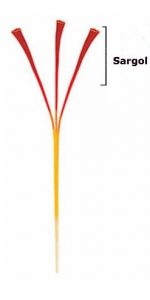
Sargol saffron is actually what is in most people’s minds of saffron. In this type, the style part (root) is completely eliminated and the red Kolaleh separately form pure saffron.
After Negin, the coloring power of Sargol is the most common (210 to 260 units)
Sargol is more common than other varieties.
Pushal Saffron

Grade 1, Grade 2 and Grade 3 Saffron is classified as Pushal.
Some people are more likely to trust this type of saffron because of the reduced likelihood of fraud.
The coloring power of this type will depend on its quality, about 170 to 250 units.
Bunch Saffron
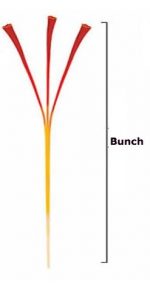
Bunch saffron is the main type of saffron that comes from stacking and drying a whole string of saffron.
Bunch is called grade 4 saffron.
The coloring power is between 120 and 150 units.
White (Konj) Saffron

By separating the Sargol from the Bunch, the root part remains in Iran called white or Corn saffron. In Europe this area is known as White or Style. Konj Saffron is not included in the category of saffron varieties.
Use of saffron in Iranian food
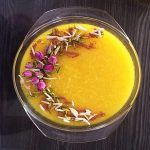 Sholeh Zard: This food is similar to Aash, cooked and mashed rice with water, saffron and rose water which has excellent taste.
Sholeh Zard: This food is similar to Aash, cooked and mashed rice with water, saffron and rose water which has excellent taste. Sonati ice cream (Bastani Sonati): Very tasty ice cream with cream or iranian pistachio.
Sonati ice cream (Bastani Sonati): Very tasty ice cream with cream or iranian pistachio.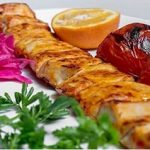 Chicken kabab (Jojeh Kabab): Roast chicken in a mixture of yogurt and saffron and onions, then roast it, It has a very pleasant taste for Iranians.
Chicken kabab (Jojeh Kabab): Roast chicken in a mixture of yogurt and saffron and onions, then roast it, It has a very pleasant taste for Iranians.
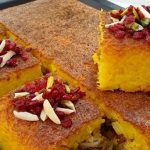 TahChin: A mixture of saffron rice with chicken, one of the most delectable Iranian food.
TahChin: A mixture of saffron rice with chicken, one of the most delectable Iranian food.In the video below, which is from the YouTube channel of the Aashpazi.com, you can see about Iranian water.
History of saffron
Saffron (the original Persian name: Zarparan [flower with its feathers like gold]) and its use by humans has been around for 3500 years. The origins and origins of saffron are native to Southwest Asia. And then it was first cultivated in Greece.
In the Achaemenid period, saffron was used to decorate bread pollen and flavor the food. According to Dariusz Shah’s history, you rub your body with aromatic oil, a blend of sunflower oil cooked in lime peel and made with saffron and date wine. At the time the Parthians sent Iran saffron to Greece and Rome, and later China became one of the Iranian customers. In the Sassanid period, saffron planting was also common in Qom and Boon and their crop quality became known.
Saffron Calories & Nutritional Value
Amount in 100 grams
310 kcal energy (calories)
| Carbohydrate | 65.37 g |
| protein | 11.43 g |
| fat | 5.85 g |
| Water | 11.90 g |
| Fiber | 3.90 g |
| Sugar | 0.00 g |
| Cholesterol | 0.00 mg |
Dried saffron vitamins, vitamin spices in 100 grams
| Vitamin A | 27.00 micrograms |
| Vitamin D | 0.00 µg |
| Vitamin E | 0.00 mg |
| Vitamin K | 0.00 µg |
| Vitamin C | 80.80 mg |
| Thiamine (B1) | 0.12 mg |
| Riboflavin (B2) | 0.27 mg |
| Niacin (B3) | 1.46 mg |
| Choline (B4) | 0.00 mg |
| Pantothenic acid (B5) | 0.00 mg |
| Vitamin B6 | 1.01 mg |
| Folate (B9) | 93.00 micrograms |
| Vitamin B12 | 0.00 mg |
Dried saffron minerals, mineral spice in 100 grams
| Calcium | 111.00 mg |
| Iron | 11.10 mg |
| Magnesium | 264.00 mg |
| Phosphorus | 252.00 mg |
| Potassium | 1724.00 mg |
| Sodium | 148.00 mg |
| On | 1.09 mg |
| Copper | 0.33 mg |
| Mn | 28.41 mg |
| Selenium | 5.60 micrograms |
Harvesting and Cultivation Saffron
It grows well in areas with subtropical or mild winters, hot and dry summers. Saffron withstands the cold as it grows in autumn, winter and early spring. It is not suitable for irrigation and rainfall during sleep or rest, and it causes onion’s to disappear.
Lands that are sunny and exposed to cold winds and without trees are suitable for saffron growth. Saffron does not grow well in soil that has no calcareous or organic matter and therefore does not produce a good crop.
It harvest starts around mid-October and lasts up to a month. The beginning of harvesting depends on the air temperature.
The saffron harvesting stage involves picking flowers and removing Kolaleh from the flower. The shelf life of flowers is 3 to 4 days and will disappear if not harvested in time. Also, if the flowers are exposed to hot air, wind, and sunlight for a long time, the color and aroma of the flowers will decrease and it’s quality will decrease.
Try Tea and Saffron
 Black tea has a cold nature, but saffron is warm and dry;
Black tea has a cold nature, but saffron is warm and dry;
So people who have a cold, if they like regular tea as saffron tea, can reduce the effects of cold on their bodies. The use of saffron in tea is also used to relax, relieve daily fatigue and enhance memory.
Green tea is warm in nature and saffron is warm and dry, so it is advisable to use more cold supplements along with this drink to soften and balance the body, thereby strengthening the body and removing diseases.
Try the Saffron and Milk
The combination of milk and saffron gives a warm, tasty drink and is calming. Adding honey to this blend will make this drink highly nutritious and help boost morale and fitness.
Try the Saffron and Rose Water
Both saffron and rose water are warm. The combination of these two is very useful for relieving stress and anxiety. Saffron and Rose hip syrup contain a variety of vitamins such as A, C, E and contains sodium, potassium, carbohydrates, fiber, protein, calcium, iron, magnesium, folic acid, manganese, and zinc. This compound has properties such as gastric bladder elimination, hematopoiesis, memory enhancement, sexual enhancement, anti-aging, relieving depression, anorexia cure, asthma and glucose treatment, hypertension and lipid and many other properties. Saffron and rose water can also be used as a mouthwash because it relieves toothache.
Also Ask About Saffron
Where did saffron come from?
- Iran
- Spain
- Netherlands
- France
- Portugal
- Germany
- Swiss
- Afghanistan
What are the Benefits of Saffron?
- Saffron cream and oil, as a common massage tool, can relieve pain throughout the body. Saffron is an amazing treat for people suffering from sports injuries, arthritis, gout and other inflammatory diseases. Also, for topical treatment of bruises and bruises and wounds, the rapid antioxidant compounds in saffron can help speed up the healing process.
- Saffron can act as an energy booster and increase your blood circulation, increasing your body’s metabolism. The presence of large amounts of iron in saffron means that the plant can increase the amount of red blood cells in your bloodstream, increasing blood circulation and oxygen delivery to the body’s systems for healthier metabolism and prevention of symptoms of anemia.
- Significant amounts of manganese in saffron can help the body optimize blood sugar levels. Controlling your blood sugar, insulin, and glucose levels can help prevent the development of type 2 diabetes, or control your symptoms if you suffer from the condition.
- Potassium in saffron, as a diuretic, reduces stress and pressure on the blood vessels and arteries, allowing blood pressure, stress and strain on the cardiovascular system to be relieved, which can lead to events such as atherosclerosis and heart attacks. And stroke is prevented.
- Saffron suppresses mild depression and improves mood in those who regularly consume saffron. The highly active ingredients in saffron have effects on the endocrine system and can be effective in intensifying the release of hormones that lead to health and happiness.
- Some of the minerals and organic compounds in saffron cause more and better absorption of nutrients, especially calcium. As we increase the amount of calcium our bodies can absorb through food, we will have a better chance of boosting our bone mineral density and thus preventing diseases such as osteoporosis and other age-related diseases.
- Pain relief is always a valuable property of a natural herb or medicine, and the combination of saffron variable in saffron acts as a sedative and analgesic for many patients. This calming effect can help relieve pain, reduce anxiety and stress, improve sleep habits, and generally calm the mind and body, which is always a good thing!
- The benefit of saffron for the gastrointestinal tract. The analgesic and anti-inflammatory nature of saffron helps to relieve stomach pain and reduce inflammation, thereby improving constipation, reducing bloating, colic and heartburn, and curing more serious diseases such as stomach ulcers.
Why Iranian Saffron?
Iranian saffron is one of the best saffron in the world. A large amount is cultivated in this area every year and sold in different types. This plant grows very well in Iran in terms of climate
Why is Saffron Expensive?
Saffron is a spice that is very difficult to harvest. Each flower has three red Kolaleh that must be separated from the main part of the flower.
To get 453.56 grams of saffron, you have to handle 170,000 flowers, so you have to hire a large number of workers.
Also, purple flowers bloom only during a period of 6 weeks from late October to early December.
